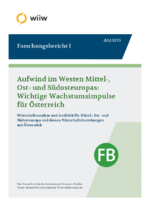Aufwind im Westen Mittel-, Ost- und Südosteuropas: Wichtige Wachstumsimpulse für Österreich
wiiw Research Report in German language No. 1, July 2015
75 pages including 95 Tables and 18 Figures
Zusammenfassung
Aufwind im Westen der MOSOEL
In den mittel-, ost- und südosteuropäischen Ländern (MOSOEL) klafft der Ausblick für das Wirtschaftswachstum auch weiterhin auseinander: für die meisten der neuen EU-Mitgliedstaaten (NMS) wird eine langsame Beschleunigung des BIP-Wachstums beginnend mit diesem Jahr erwartet. Für 2015 soll das Wachstum durchschnittlich auf 3% ansteigen, um 0,2 Prozentpunkte mehr als im Vorjahr. Die Erholung erfolgt um ein Jahr früher als erwartet. Wesentlicher Faktor ist die bessere Entwicklung in der Eurozone. Auch am Westbalkan wird eine (wenn auch weniger dynamische) Verbesserung der Wachstumsaussichten für die gesamte Prognoseperiode 2015-2017 erwartet. Die wirtschaftliche Entwicklung 2015 in Weißrussland, Kasachstan, Russland und der Ukraine wird düster ausfallen und zum Teil noch schlechter sein als bisher erwartet. Für diese Länder sind die mittelfristigen Wirtschaftsaussichten auch mit substantiellen Risiken behaftet. Insgesamt sollte aber das verstärkte Wachstum in den MOSOEL für die österreichische Wirtschaft als Nachfrageimpuls dienen. Insbesondere die NMS sind für Österreich von zunehmender Bedeutung.
English Summary
Western CESEE countries in the ascendant
The outlook for GDP growth in the Central, East and Southeast Europe (CESEE) region remains divergent: we expect a gradual acceleration of GDP growth for most of the EU’s new Member States (NMS) starting this year. For 2015 growth is expected to increase to 3% on average, by 0.2 pp more as compared to last year. The recovery comes a year earlier than expected mainly based on favourable developments in the euro area. In the Western Balkans growth prospects will also improve over the whole forecast period 2015-2017, though slightly less dynamically. Growth performance in Belarus, Kazakhstan, Russia and Ukraine in 2015, however, will be dismal and partly worse than expected; the medium-term outlook for these countries is also fairly uncertain with considerable downside risks. Overall though, we should expect stronger CESEE growth to act as a demand stimulus for the Austrian economy. The NMS in particular are of increasing importance for Austria.
Reference to wiiw databases: wiiw Annual Database, wiiw Monthly Database
Keywords: macroeconomic analysis, international trade, competitiveness, consumption, investment, savings, global financial crisis
JEL classification: E20, F34, G01, O52, O57, P24, P27, P33, P52
Countries covered: Albania, Belarus, Bosnia and Herzegovina, Bulgaria, Croatia, Czechia, Estonia, Hungary, Kazakhstan, Kosovo, Latvia, Lithuania, North Macedonia, Montenegro, Poland, Romania, Russia, Serbia, Slovakia, Slovenia, Turkey, Ukraine, Austria
Research Areas: Macroeconomic Analysis and Policy, Labour, Migration and Income Distribution, International Trade, Competitiveness and FDI
Press Releases
Related Presentations
- Western CESEE countries in the ascendant (press conference presentation in English)
- Aufwind im Westen Mittel-, Ost- und Südosteuropas: Wichtige Wachstumsimpulse für Österreich (press conference presentation in German)
